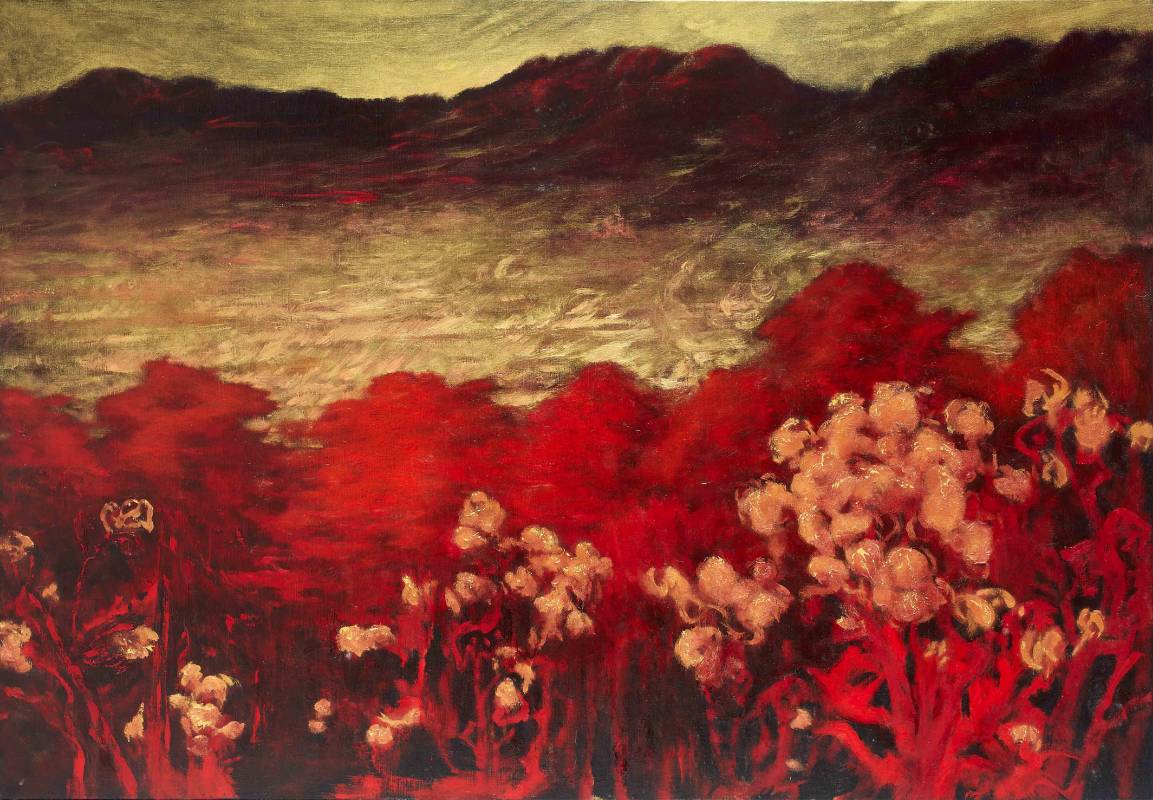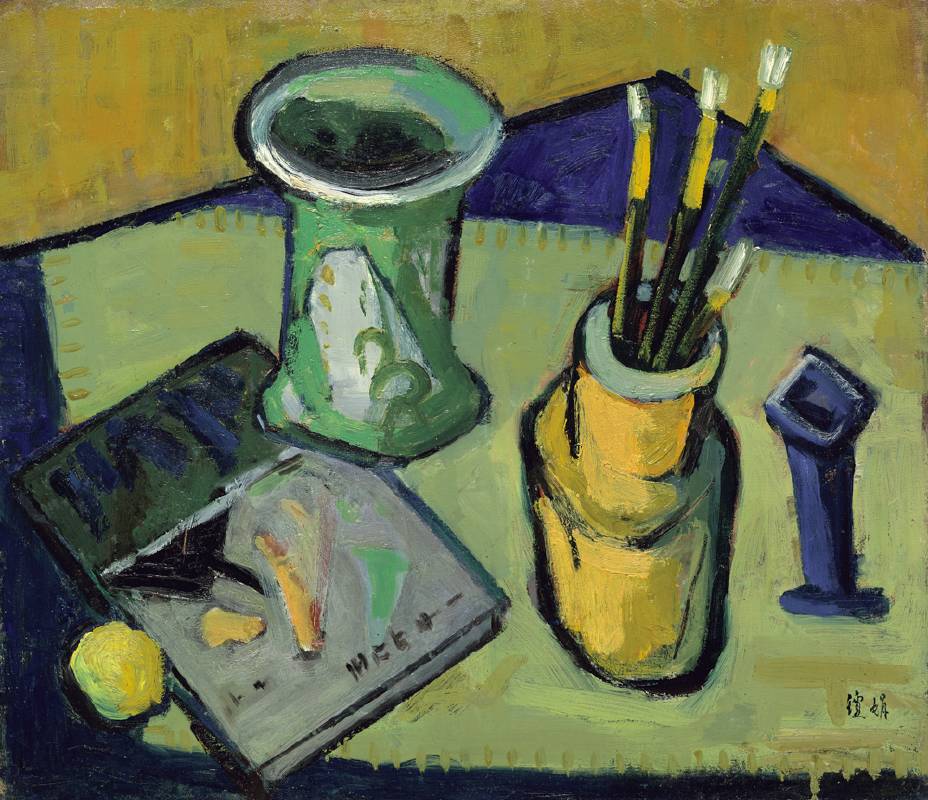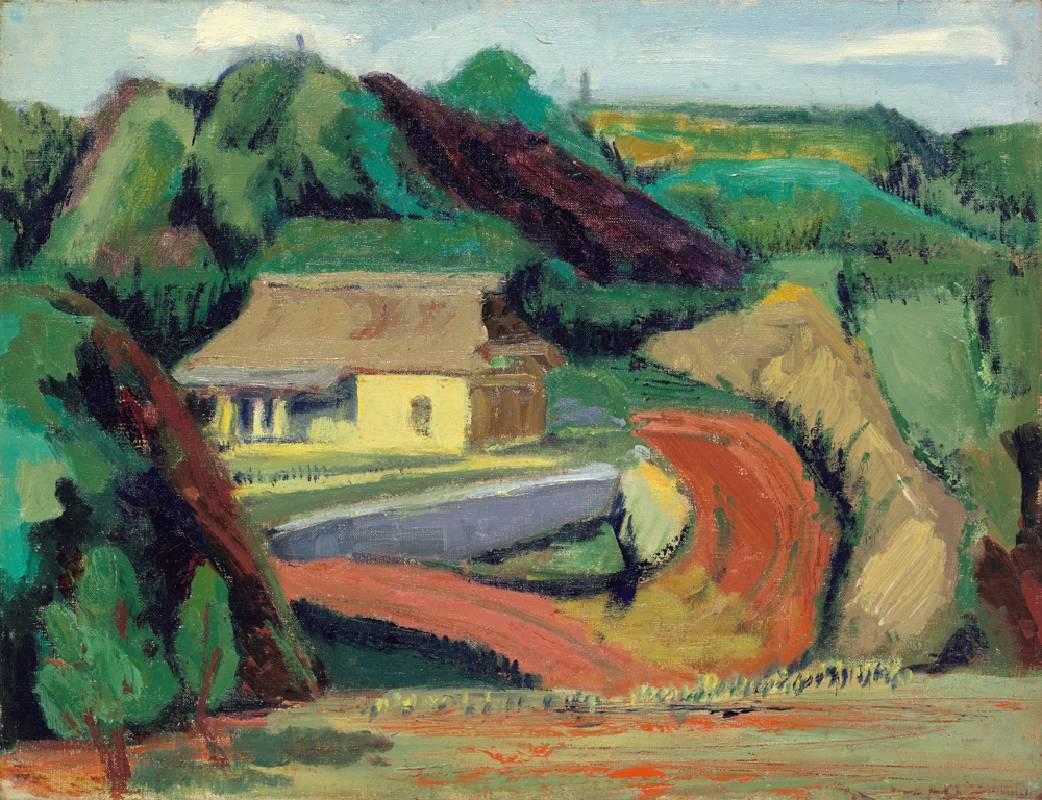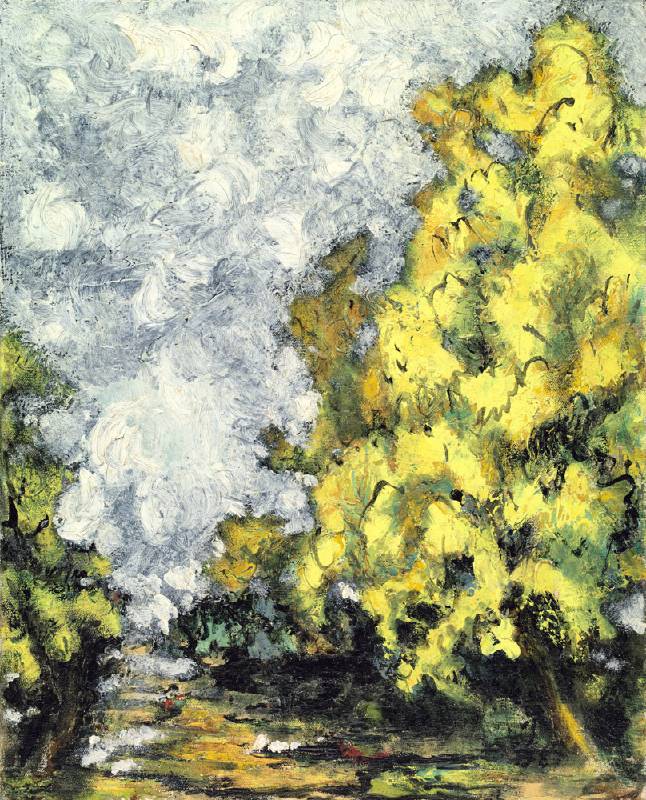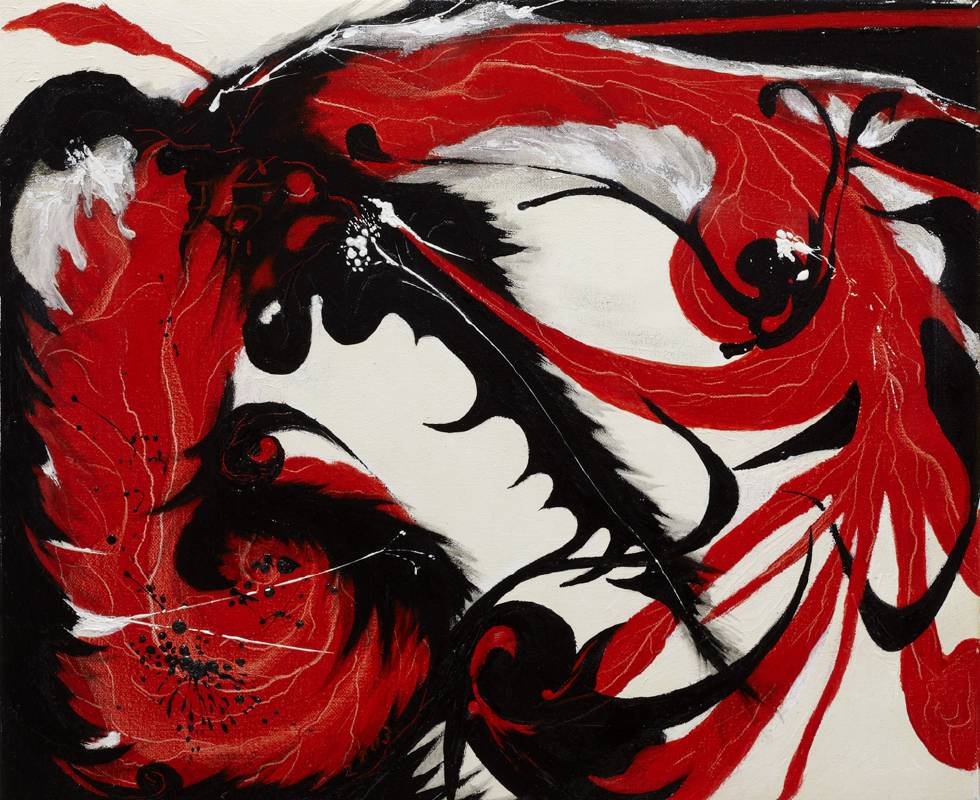紅野畫廊
【燁燁 - 鄭瓊娟創作歷程展】Cheng Chung-chuan: Blaze of Glory
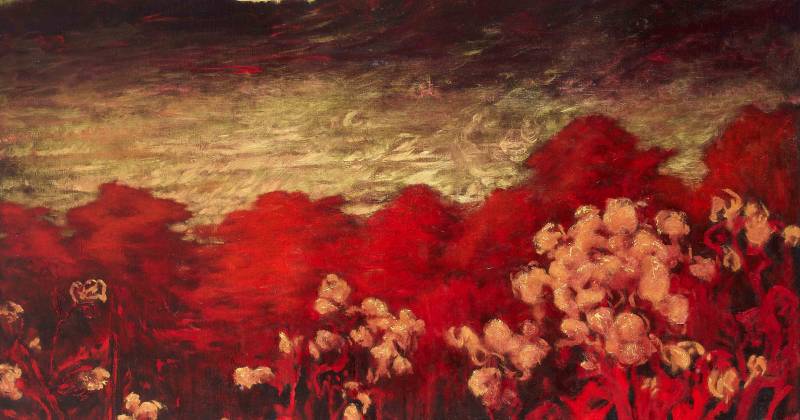
-
展期
日期:2020-09-05 ~ 2020-10-11
-
地點
台北市中山區松江路164巷11號
-
參展藝術家
鄭瓊娟 Cheng Chung-chuan
-
燁燁 - 鄭瓊娟創作歷程展
Cheng Chung-chuan: Blaze of Glory
展期 Duration|September 5 – October 4, 2020 (延長展期至October 11)
開幕 Opening|September 5, 2020 Sat. 2:00 p.m.
地點 Venue|紅野畫廊 Powen Gallery(台北市中山區松江路164巷11號,10:00-19:00 週一休館 Closed on Mondays)
柔韌的詩情 : 鄭瓊娟作品展
文 / 劉永仁 LIÚ Yung-Jen
鄭瓊娟(b.1931)的藝術創作歷程始於藝術荒蕪的五O年代,然而也是她開展創作才情的金色年華,早年參與前衛畫會與現代繪畫,之後羈旅日本體驗生活中的酸甜苦澀,在異國生活雖備嘗艱辛,卻不改其繪畫的熱情與毅力,在台灣美術進展中,可說是早期極少數優秀的女性畫家之一,在篳路藍縷的時代,殊為難能可貴。鄭瓊娟的作品表達的精神透露出溫馨恬靜、女性敏感的情感波瀾、人生的複雜感受與困惑,以及追求生命與理想的渴望,從年輕持續自由創作情感抒發綿長延續至今。
鄭瓊娟出身於新竹望族家庭,父親開設同仁醫院、也是新竹市協議會員,母親是清末文人李錫金曾孫,稱得上家世背景優渥。鄭瓊娟在1952年考入師大美術系,授課教授如 : 朱德群、廖繼春、溥心畬等多位老師,並至李石樵畫室勤練素描,開啟了現代藝術之門。1957年,畫家廖繼春推薦鄭瓊娟和陳景容參加「五月畫會」與郭東榮、劉國松、李芳枝、郭豫倫同為創始會員,該畫會第一次展出於台北中山堂,鄭瓊娟也在同年結婚,與夫婿旅居東京長達三十年,然因相夫教子與操持家務以及種種未能得到支持等因素,她曾經中斷創作十年,亦即從一個成長順遂充滿藝術理想的畫家,到異國他鄉欲繼續追求藝術夢想而受阻,有極大的落差,在那段期間心靈的鬱悶與孤寂無助誠然不言可喻。
鄭瓊娟的藝術創作靈感來自於自然大地之華,以植物花草與藝術表現交織多元想像,尤其關注視覺要素的自律性,她透過敏銳的思緒繪寫於畫布上,其繪畫經常以金黃色調的花卉各式各樣變奏構成視覺對比,有意識地展現出自然生命的內在結構,她描寫物象不斷的蛻變衍生,它們在顫動徐緩空間中運動,形成不拘泥形式的圖像,我們可視為自然抒情的心靈圖像,欲理解其篤實堅定的情愫,必須在她真實的內心去探究隱喻的風景。畫者與物象之間存在一種微妙的審美關係,如何表現賦予新的視覺語彙,往往是取決於畫家的涵養心性與技藝,鄭瓊娟的繪畫並非只是描寫自然的再現,而是通過主觀詮釋提煉與昇華,釋放出畫家真摯情感雍容大度的氣質。
早年鄭瓊娟油畫的題材以人物肖像居多,多半是家庭生活場景,母親與孩子以及自畫像,這些畫作顯然是反映她孰悉親切的對象,以及探討女性多重身分認同的生存環境。從心事浩繁牽連投射到廣博的寰宇,是畫家的日常也是觸及思考的想像空間,將平凡的現實延展至藝術視野蘊涵的生命意識,鄭瓊娟在畫布上自由盡情揮灑,躍動的筆觸,以濃郁的色彩,藉由物象畫出個人純真柔韌的性情烙痕,自由自在無拘表露無遺。創作者以油畫繪寫表現娟秀風景,色彩因素當然十分重要,尤其形色材質在空間的組構確是吸引觀者欣賞的關鍵要素。鄭瓊娟在訪談自述提及偏愛暖色系,紅色及黃色特別喜歡,檢視其作品中的色彩沒有直接明暗光影,主要是發自內心的情緒性色彩,畫面中的金黃、赭褐大地之色,空靈而不滑膩,凝鍊沉穩而略帶奢華的氛圍,從視覺審美角度來看,充滿生機盎然之韻味,但卻又趨近於和諧寧靜的統調。
90年代初,鄭瓊娟決定從日本重回台灣並持續創作,也陸續發表新作,進而再度受到台灣藝壇關注。鄭瓊娟以繪畫解放其心靈桎梏,所有的委屈與苦悶皆化為優雅的繪畫作品,表達自身的感受處境,堅強的意志伴隨颤動的筆法,她表現花草生存的意志與物種柔和卻又勁健豪放的特質,鄭瓊娟繪寫花草,飄逸如精靈、或逆風起舞、或虛實朦朧,筆意蒼勁內裡透露柔媚的張力;可以看到近年來鄭瓊娟的作品,從嚴謹與收斂之中,愈加逐漸釋放原初被壓抑的熱情,由具象轉趨簡約抽象的單純色彩,單色相中富含紋理或濃或輕盈的層次,微觀每幅畫作頗有展現巨視的氣勢,筆觸的收斂與放縱已然達到隨心所欲的境況,換言之,畫家的發展狀態會隨著年齡增長與心境蛻變產生不同階段的風格變動。觀讀鄭瓊娟油畫作中似花草非花卉的造形,宛如在漩渦般翻騰,而漩渦伴隨抖動的筆觸屢屢出現於畫面上,形成辨識其藝術身分的記號;又如表現四季節氣、日月星辰、雲蒸霞蔚激起澎湃的水花、流動的雲彩變化,以近乎特寫感性澄明的表現手法,花草與雲煙共乘昇華的意像,或可視為畫家作品鮮明獨特的視覺語彙。
鄭瓊娟以其堅定的藝術信仰建立新的視覺秩序,於是在日常生活中的不安與困惑得以超越常規,繪畫不僅是鄭瓊娟認識傾聽自然的心靈之窗,更是細水長流的獨白,由此獲致精神上無限的安頓與永恆的歸宿感。作為台灣資深的女畫家之一,鄭瓊娟從20世紀跨越至21世紀,走過漫長豐盛的歲月,將近90高齡的她以繪畫作為一種觀看世界的方式,真誠浪漫情懷和創作演繹豐富的視覺圖像,既是探討其個人生命歷程深刻的寫照,映照台灣女性創作的發展歷程,現今我們更欣見她的創作能量仍在更堅毅燦爛的拓展進行中。
Poetics of Resilience: Cheng Chung-Chuan Exhibition
Article by LIÚ Yung-Jen
Cheng Chung-Chuan (b. 1931) started painting in the 1950s, which was during Taiwan’s art barren period, yet it was a golden period for Cheng. In her early years, Cheng took part in avant-garde and modernist movement. Later on, she went to Japan and embraced the life there. Despite the challenges of living in a foreign country, she persevered with her passion for painting. For the development of art in Taiwan, Cheng is said to be one of the very few outstanding female painters during that early period, and her skills were particularly precious in a time of limited resources. Cheng Chung-Chuan’s works expressed a spirit of warmth and serenity, waves of emotions specific to women, life’s complex sentiments and perplexities, and a yearning for the quest of life and ideals. The above sentiments and themes have been expressed freely in Cheng’s works since youth to this day.
Cheng Chung-Chuan came from a well-respected family in Hsinchu. Her father founded the Tung-Jen Hospital and was also a Hsinchu councilor. Her mother was the great-granddaughter of Li Xi-Jing, a literatus from the late Qing Dynasty. One can say that Cheng’s family was prominent and affluent. Cheng passed the entrance exam for the Fine Arts Department at National Taiwan Normal University in 1952 where she trained with professors such as Chu Teh-Chun, Liao Chi-Chun, Pu Hsin-Yu and many others. She also practiced sketching diligently in Lee Shih-Chiao’s studio, which set her off on the path of modern art. In 1957, Liao Chi-Chun the painter recommended Cheng Chung-Chuan and Chen Jing-Rong to join the Fifth Moon Group along with its founding members: Guo Dong-Rong, Liu Gong-Song, Li Fang-Zhi and Guo Yu-Lun. The group hosted its inaugural exhibition in Taipei Zhongshan Hall, and in the same year (1957), Cheng got married, subsequently moved to Tokyo and lived there with her husband for 30 years. At a point, Cheng halted painting for 10 years due to her family duties, her role as a wife and a mother including other reasons. That is to say, transiting from living a sheltered life as a painter full of ideals to moving overseas and wanting to pursue her art dream has come with great unexpected obstacles. The despair, helplessness, and loneliness her soul endured during that period must have been grave beyond words.
Cheng Chung-Chuan draws inspiration from nature for her art creation and manifests her imagination through a diverse interplay of plants, flowers, and art. She gives specific focus to the innate rhythm of visual elements and transforms her acute thinking onto the canvas. Her painting usually comprises of visual contrasting by painting golden yellow flowers in widely varied dissonance, through which the inner structure of nature and life unfolds consciously. Objects are depicted to be constantly evolving and generating; they move in a slowly pulsating space and take up a shape unconfined by form. We can view them as images for the soul that speak for nature. To grasp her steadfast sentiments requires exploration of metaphorical landscape that resides within her true self. Between the painter and the objects painted exist a certain delicate critique relationship. How to bring forth and express with a renewed visual vocabulary often depends on the painter’s character as a person and craft as an artist. Cheng Chun-Chuan’s painting is more than a re-presentation of nature depiction but a refinement and transcendence through objective interpretation. Her painting is a manifestation of released genuine emotions and disposition that are all encompassing.
In her early years, Cheng Chun-Chuan usually painted portraits as the motif, mostly with scenes of family life as the background featuring mothers, children, and her self-portraits. These paintings evidently reflect the subjects that she was most familiar with and explore the environments where women exist as multiple roles and identifications. The painter’s realm of imagination, ranging from vexing trivia for the mind to projections of vast universe, covers her daily life as well as cognitive musing. Extending mundane realities to consciousness of life imbued with artistic visions, Cheng expresses herself freely on the canvas with dancing movements of the brush and robust colors to bring forth her personal character of innocence and resilience through the depiction of objects and images, as is done so freely and unrestrictedly. The artist portrays elegant landscapes with oil painting where colors play a critical factor, and particularly, the spatial arrangement of shapes, colors and materials is the key element that draws in the viewer to appreciate the painting. In an interview, Cheng once mentioned her preference for warm colors, specifically red and yellow. An examination of her works will reveal that colors used in her painting are not presented with expected light and shadow, brightness and darkness. Rather, they are colors of emotions surging from the heart. In her painting, the golden yellow or brown colors of the earth, are not trite but ethereal, grounded and mellow, with an ambience of slight opulence. Viewed from the perspective of visual critiques, her works are permeated with an enduring charm full of vitality and vigor, yet approximating a harmonizing tone of consonance and serenity.
In the early 90s, Cheng Chun-Chuan decided to move back to Taiwan from Japan and continued to paint and intermittently launched new works. Subsequently, she started to receive attention from Taiwan’s art circle once again. Cheng painted to free herself from mental shackles, turning the sum of all her sorrow, injustice and anguish into graceful painting where she expresses her feelings and her positions. With her pulsating brush approach accompanied by a strong drive, Cheng expressed the floras’ will to survive and the species’ gentle yet relentless and ferocious traits. Cheng’s depiction of floras is as light as breezes and as enchanting as fairies, occasionally dancing against the wind or becoming elusive and opaque or suddenly coming into sight again. In her powerful brush movement exists a charged innate feminine strength. Cheng’s works of the recent years reveal, amid her rigorousness and reticence, a gradual release of passion that was previously subdued, going from concrete images to simplistic abstract pure colors. Cheng infuses single-color paintings with patterns and layers, heavy or light. Inspected closely, each painting rather demonstrates an expansive vision. Her maneuver of the brush in its retrieval and release has reached a supreme state of complete freedom aligned with the heart. In another word, the painter’s development will vary in style at different stages according to the age and psychological transformation. Viewing and reading the flora-like or non-flora-like shapes in Cheng’s oil painting is like seeing floras swirling in a vortex which often appear on the canvas by way of Cheng’s pulsating brush movements to form a signature mark of the artist. Further, various shapes of water stirred up under the steaming moving clouds and sky at dusk, or the stars, the sun and the moon, or the four seasons, are expressed in such an approach full of sentiments and clarity that is almost highlighting the object in a close-up shot. Such an approach exudes an imagery of floras ascending with smokes and clouds, and can be seen as the painter’s sharp and distinct visual vocabulary.
Cheng Chung-Chuan has built a new order of seeing with her staunch artistic belief. As a result, any unease and confusion in everyday life can then surpass the norm. Not only is painting the window to her soul through which Cheng Chung-Chuan meets the world, but it also comes across as a stream-like extensive monologue that will bring about a spiritual sense of eternal belonging and infinite ease. As one of Taiwan’s senior female painters, Cheng has crossed from the 20th century to the 21st century. Spanning over a long period of time, at nearly 90 years old, she resorts to painting as a way of seeing the world, and her works of visual imageries are rendered with sincere romantic sentiments and rich interpretative creations portraying a deep exploration of her personal life experiences while reflecting the development process of Taiwan’s female artists. Today we are pleased to see her creative energy continuing to thrive and expand in an ever more splendid manner.
